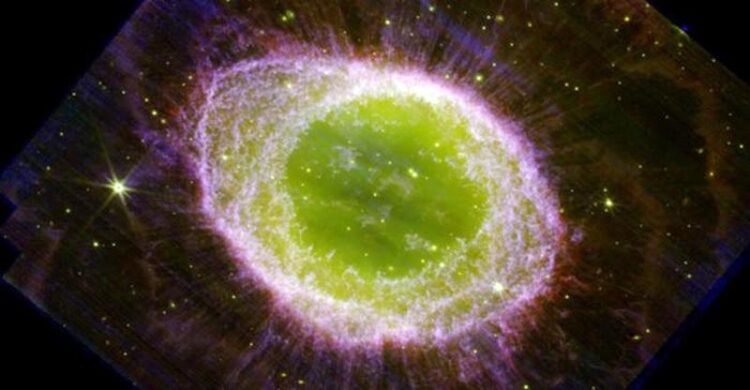James Webb Space Telescope captures stunning images of the Ring Nebula

JWST/NIRcam composite image of the Ring Nebula. The images clearly show the main ring, surrounded by a faint halo and with many delicate structures. The interior of the ring is filled with hot gas. The star which ejected all this material is visible at the very centre. It is extremely hot, with a temperature in excess of 100,000 degrees. The nebula was ejected only about 4000 years ago. Technical details: The image was obtained with JWST's NIRCam instrument on August 4, 2022. Images in three different filters were combined to create this composite image: F212N (blue); F300M (green); and F335M (red).
Credit: The University of Manchester
NASA’s James Webb Space Telescope (JWST) has recorded breath-taking new images of the iconic Ring Nebula, also known as Messier 57.
The images, released today by an international team of astronomers led by Professor Mike Barlow (UCL, UK) and Dr Nick Cox (ACRI-ST, France), with Professor Albert Zijlstra of The University of Manchester, showcase the nebula’s intricate and ethereal beauty in unprecedented detail, providing scientists and the public with a mesmerizing view of this celestial wonder.
For many sky enthusiasts, the Ring Nebula is a well-known object that is visible all summer long and is located in the constellation Lyra.
A small telescope will already reveal the characteristic donut-like structure of glowing gas that gave the Ring Nebula its name.
The Ring Nebula is a planetary nebula – objects that are the colourful remnants of dying stars that have thrown out much of their mass at the end of their lives.
Its distinct structure and its vibrant colours have long captivated the human imagination and the stunning new images captured by the JWST offer an unparalleled opportunity to study and understand the complex processes that shaped this cosmic masterpiece.
Albert Zijlstra, Professor in Astrophysics at the University of Manchester, said: “We are amazed by the details in the images, better than we have ever seen before. We always knew planetary nebulae were pretty. What we see now is spectacular.”
Dr Mike Barlow, the lead scientist of the JWST Ring Nebula Project, added: “The James Webb Space Telescope has provided us with an extraordinary view of the Ring Nebula that we’ve never seen before. The high-resolution images not only showcase the intricate details of the nebula’s expanding shell but also reveal the inner region around the central white dwarf in exquisite clarity. We are witnessing the final chapters of a star’s life, a preview of the Sun’s distant future so to speak, and JWST’s observations have opened a new window into understanding these awe-inspiring cosmic events. We can use the Ring Nebula as our laboratory to study how planetary nebulae form and evolve.” The Ring Nebula’s mesmerizing features are a testament to the stellar life cycle.
Approximately 2,600 lightyears away from Earth, the nebula was born from a dying star that expelled its outer layers into space. What makes these nebulae truly breath-taking is their variety of shapes and patterns, that often include delicate, glowing rings, expanding bubbles or intricate, wispy clouds.
These patterns are the consequence of the complex interplay of different physical processes that are not well understood yet. Light from the hot central star now illuminates these layers.
Just like fireworks, different chemical elements in the nebula emit light of specific colours. This then results in exquisite and colourful objects, and furthermore allows astronomers to study the chemical evolution of these objects in detail.
Dr Cox, the co-lead scientist, said: “These images hold more than just aesthetic appeal; they provide a wealth of scientific insights into the processes of stellar evolution. By studying the Ring Nebula with JWST, we hope to gain a deeper understanding of the life cycles of stars and the elements they release into the cosmos.”
The international research team analysing these images is composed of researchers from the UK, France, Canada, USA, Sweden, Spain, Brazil, Ireland and Belgium.
They say that JWST/MIRI images of the Ring Nebula are coming soon.
Media Contact
Jessica Marsh
University of Manchester
jessica.marsh@manchester.ac.uk
Cell: 07780281312
All latest news from the category: Physics and Astronomy
This area deals with the fundamental laws and building blocks of nature and how they interact, the properties and the behavior of matter, and research into space and time and their structures.
innovations-report provides in-depth reports and articles on subjects such as astrophysics, laser technologies, nuclear, quantum, particle and solid-state physics, nanotechnologies, planetary research and findings (Mars, Venus) and developments related to the Hubble Telescope.
Newest articles

Innovative 3D printed scaffolds offer new hope for bone healing
Researchers at the Institute for Bioengineering of Catalonia have developed novel 3D printed PLA-CaP scaffolds that promote blood vessel formation, ensuring better healing and regeneration of bone tissue. Bone is…

The surprising role of gut infection in Alzheimer’s disease
ASU- and Banner Alzheimer’s Institute-led study implicates link between a common virus and the disease, which travels from the gut to the brain and may be a target for antiviral…

Molecular gardening: New enzymes discovered for protein modification pruning
How deubiquitinases USP53 and USP54 cleave long polyubiquitin chains and how the former is linked to liver disease in children. Deubiquitinases (DUBs) are enzymes used by cells to trim protein…


